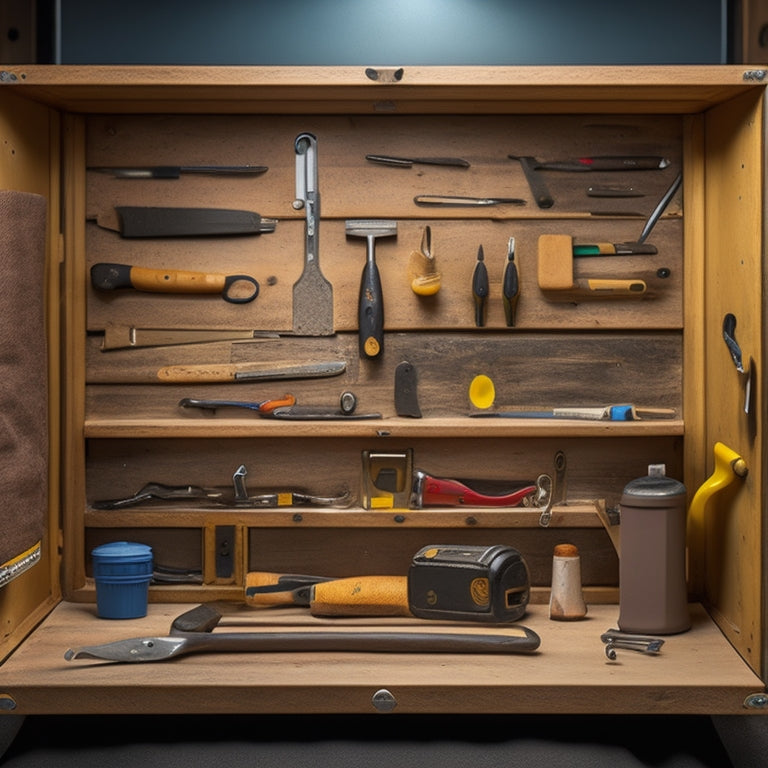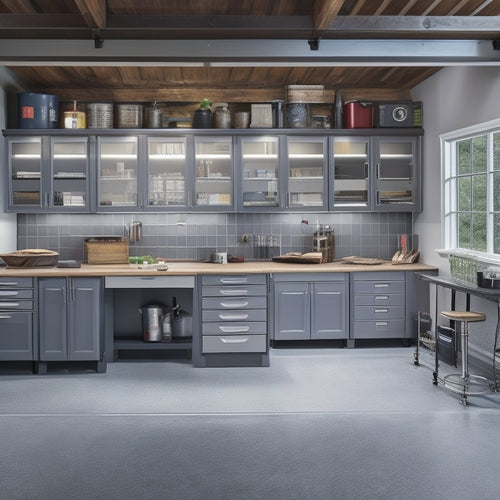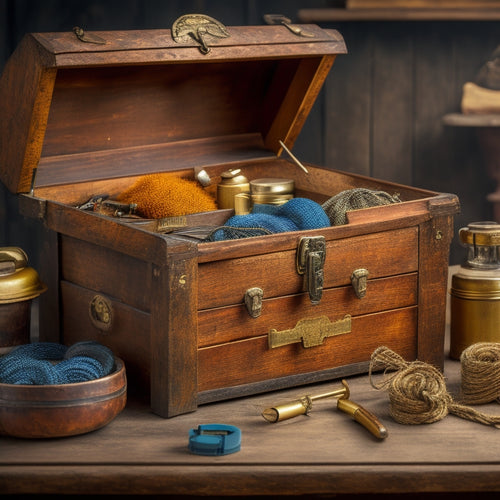
Essential Tools in a Homeowner's Tool Box Set
Share
When it comes to tackling everyday tasks and DIY projects, you need a well-stocked tool box with the right essentials. You'll want to start with hand tools like a screwdriver set, hammer, pliers, wrenches, and a tape measure. Next, consider power tools like a drill press and cordless tools for added versatility. Measurement and testing devices, such as a voltage tester and leveling tools, will also come in handy. Don't forget fastening and joining tools, cutting and shaping tools, and safety gear like protective eyewear and gloves. With these essentials, you'll be well-equipped to handle most tasks - and there's more to investigate to take your DIY skills to the next level.
Key Takeaways
- A screwdriver set, hammer, pliers, wrenches, and tape measure are essential hand tools for everyday tasks and DIY projects.
- Power tools like a drill press and cordless tools enhance project versatility and flexibility, but require regular maintenance and safety protocols.
- Measurement and testing devices, including tape measures, voltage testers, and leveling tools, ensure accurate measurements and safety in electrical work.
- Fastening and joining tools, such as screws, joint techniques, and socket sets, are necessary for successful DIY projects and repairs.
- Safety and protective gear, including protective eyewear, hearing protection, safety gloves, respirator masks, and a first aid kit, are crucial for preventing injuries and accidents.
Hand Tools for Everyday Tasks
You likely find yourself tackling various tasks around the house on a daily basis, from tightening loose screws to prying open stuck drawers. Having the right hand tools can make all the difference in getting these tasks done efficiently and safely.
A good screwdriver set is essential, with both flathead and Phillips-head drivers in various sizes. This will allow you to tackle tasks such as assembling furniture, tightening loose screws, and prying open stuck parts.
A hammer is another must-have, with uses ranging from driving nails to tapping pieces into place. When choosing a hammer, consider the weight and balance, as well as the material of the handle and head.
Other essential hand tools include pliers, wrenches, and a tape measure. Pliers are great for gripping and twisting objects, while wrenches provide the necessary torque for loosening stuck parts.
A tape measure allows you to accurately measure spaces and objects, ensuring a proper fit. By having these hand tools at your disposal, you'll be well-equipped to handle everyday tasks around the house.
Essential Power Tools for Homeowners
You'll want to prioritize a few essential power tools to tackle various tasks around the house.
A drill press is a must-have for precise drilling and driving, and you'll appreciate the versatility it brings to your projects.
Additionally, consider cordless convenience options that offer flexibility and ease of use.
Drill Press Essentials
A sturdy workbench is often the centerpiece of a homeowner's workshop, and a drill press is typically its most reliable companion. You'll appreciate the precision and control a drill press offers when working on projects that require repeated drilling operations.
When selecting a drill press, look for features such as variable speed control, a large worktable, and an accurate depth stop. These features will help you achieve precise results and prevent accidents.
Regular drill press maintenance is essential to guarantee your tool remains safe and functional. You should regularly clean the drill press, lubricate moving parts, and check for wear on the belts and bearings.
Additionally, always follow safety guidelines when operating a drill press, such as wearing protective eyewear and keeping loose clothing tied back. By doing so, you'll be able to enjoy the benefits of a drill press while minimizing the risk of accidents.
With proper care and maintenance, your drill press will remain an important asset in your workshop for years to come.
Cordless Convenience Options
Tackle projects anywhere with cordless convenience options, which have revolutionized the way homeowners work. No longer are you limited by cords or outlets, allowing you to take on tasks in remote areas or hard-to-reach spaces.
When selecting cordless tools, consider the battery life to guarantee you have enough power to complete your project. Look for tools with high-capacity batteries and rapid charging capabilities to minimize downtime.
Portability features are also essential in cordless tools. Opt for tools with compact designs and lightweight builds, making them easy to maneuver and transport. Additionally, consider tools with belt clips or carrying cases to keep them within reach while working.
With cordless convenience options, you'll enjoy increased flexibility and freedom to tackle projects anywhere, anytime. By choosing the right cordless tools, you'll be able to work smarter, not harder, and achieve professional-grade results with ease.
Measurement and Testing Devices
You'll use measurement and testing devices daily to guarantee your DIY projects are accurate and safe.
From checking the width of a room to verifying the voltage of an electrical outlet, these tools are essential for any homeowner.
In this section, you'll learn about the must-haves, including tape measure essentials, leveling made easy, and voltage tester safety.
Tape Measure Essentials
Every homeowner needs a reliable tape measure in their toolkit, as it's an essential device for taking accurate measurements.
You'll use it for everything from hanging images to building decks, so it's vital to choose the right one for the job.
There are several tape measure types to take into account, including fiberglass, steel, and pocket tapes.
Fiberglass tapes are great for general-purpose measuring, while steel tapes are more durable and suitable for heavy-duty use.
Pocket tapes are compact and convenient for quick measurements.
When it comes to measuring accuracy, look for a tape measure with a clear, easy-to-read scale.
A 1/16-inch increment scale is standard, but some tapes offer 1/32-inch or even 1/64-inch increments for more precise measurements.
Reflect on a tape with a rugged hook or clamp that securely attaches to surfaces, ensuring accurate readings.
Leveling Made Easy
Accurate measurements are only half the battle - verifying your work is level is just as important. You'll need reliable leveling techniques to get the job done. That's where a laser level comes in. This handy tool projects a level line or dot onto surfaces, allowing you to accurately check the levelness of your work.
With a laser level, you can confirm that shelves, cabinets, and floors are properly aligned, which is vital for both aesthetics and safety.
When choosing a laser level, consider the type of projects you'll be working on. For smaller tasks, a compact, self-leveling laser level may suffice. For larger projects, such as installing cabinets or tiling, a more advanced model with multiple leveling modes may be necessary.
Regardless of the type, make sure to follow the manufacturer's instructions and take necessary safety precautions when using your laser level. With this indispensable tool in your toolbox, you'll be able to tackle leveling tasks with confidence and precision.
Voltage Tester Safety
Your tool box isn't complete without a voltage tester, a device that helps you detect the presence or absence of voltage in electrical wires and devices. This essential tool guarantees electrical safety by preventing shocks, electrocution, and even fires. When using a voltage tester, always follow voltage precautions to avoid accidents.
Here's a breakdown of voltage tester safety guidelines:
| Safety Guideline | Description |
|---|---|
| Always turn off power | Verify the power is off before testing to avoid electrical shock |
| Use the correct tester | Select a tester rated for the voltage you're testing to guarantee accuracy |
| Test before touching | Verify the absence of voltage before touching wires or devices |
| Keep testers clean | Regularly clean your tester to guarantee accurate readings |
Fastening and Joining Tools
As you tackle various projects around the house, you'll find that fastening and joining tools are essential for holding things together. These tools help you assemble, disassemble, and secure parts and components, guaranteeing your projects turn out sturdy and reliable.
When it comes to fastening, you'll need a variety of screw types, such as flathead, Phillips, and hex (or Allen) wrench-compatible screws. Each type is suited for specific tasks and materials.
For joining, you'll want to excel in different joint techniques, like butt joints, lap joints, and mortise-and-tenon joints.
Here are four essential fastening and joining tools to include in your toolbox:
- Hammer: A versatile tool for driving nails, fitting parts together, and breaking apart objects.
- Tape measure: Accurately measure distances, widths, and heights to guarantee precise fastening and joining.
- Level: Confirm your projects are properly aligned and plumb to prevent structural weaknesses.
- Socket set: A collection of sockets in various sizes for working with bolts and nuts.
With these tools and a solid understanding of screw types and joint techniques, you'll be well-equipped to tackle a wide range of projects safely and effectively.
Cutting and Shaping Tools
Beyond fastening and joining, cutting and shaping tools help you refine and customize materials to fit your project's specific needs.
You'll need a variety of saws to tackle different cutting tasks. A handsaw or coping saw is ideal for curved cuts, while a circular saw or reciprocating saw is better suited for straight cuts and demo work. Don't forget a miter saw for precise angled cuts.
In addition to saws, you'll need shaping tools to smooth and refine your materials. Sandpaper and a sanding block help remove imperfections and create a uniform surface. A rasp or file can be used to shape and smooth metal or wood.
For more advanced shaping techniques, consider investing in a router or jigsaw. These power tools allow for intricate cuts and designs, taking your projects to the next level.
With these cutting and shaping tools in your arsenal, you'll be able to tackle a wide range of projects and achieve professional-looking results.
Safety and Protective Gear
Protecting yourself from harm is vital when working with power tools and materials. You don't want to end up with an injury that could've been easily prevented. Having the right safety and protective gear in your tool box set is essential.
Here are some vital safety items to include:
-
Protective Eyewear and Hearing Protection: Safety glasses or goggles protect your eyes from debris, while earplugs or earmuffs shield your hearing from loud noises.
-
Safety Gloves and Knee Pads: Gloves prevent cuts and abrasions on your hands, while knee pads provide cushioning and support for your knees when working on floors or surfaces.
-
Respirator Masks and First Aid Kit: Respirator masks filter out dust and particles, and a first aid kit should always be on hand in case of accidents.
- Hard Hats, Safety Vests, and Fall Protection: Hard hats protect your head from falling objects, safety vests increase visibility, and fall protection gear prevents accidents when working at heights.
Frequently Asked Questions
What Is the Ideal Number of Tools for a Beginner's Toolbox?
When starting out, you'll want to focus on basic tool essentials, like a hammer, tape measure, and pliers. Aim for 10-15 beginner tool recommendations, covering tasks like hanging, drilling, and tightening, to create a solid foundation for your DIY escapades.
Can I Use a Single Tool for Multiple Tasks?
Grab your trusty sword, knight, and get ready to conquer the world of DIY! You can indeed use a single tool for multiple tasks, thanks to multi-tasking tools that offer incredible tool versatility, saving you space and hassle.
How Often Should I Sharpen My Cutting Tools?
You should sharpen your cutting tools regularly, ideally after every 3-5 uses, to maintain their effectiveness and prevent accidents. Establish a maintenance schedule to guarantee your cutting techniques stay sharp and safe.
Are Toolboxes With Wheels Worth the Extra Cost?
You're worried wheels will add bulk, but trust us, the extra cost is worth it - durable toolbox materials and smooth-rolling wheels make your kit effortlessly portable, saving energy and reducing strain on your back.
Can I Share My Toolbox With Another Family Member?
You can share your toolbox with another family member, but it's essential to establish clear tool sharing guidelines and maintain a well-organized toolbox to avoid misplacement and guarantee everyone's safety while using the shared tools.
Conclusion
You've now got a solid foundation for your tool box set. According to the US Census Bureau, the average American moves 11.7 times in their lifetime, meaning it's likely you'll encounter various DIY projects. Having these essential tools will save you time, money, and frustration. Stay handy, stay happy!
Related Posts
-

Best Tool Chests for Home Garage Options
When selecting the best tool chest for your home garage, you'll want to evaluate top brands like DeWalt, Milwaukee, a...
-

Heavy-Duty Commercial Rolling Shelving Racks
You need heavy-duty commercial rolling shelving racks that optimize your storage capacity, streamline operations, and...
-

What Are the Advantages of a Wooden Tool Box
You choose a wooden tool box, you're not only getting a reliable storage solution, but also a long list of benefits t...


